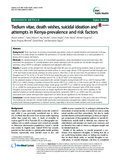Tedium vitae, death wishes, suicidal ideation and attempts in Kenya-prevalence and risk factors

View/
Date
2015-08-08Author
Jenkins, Rachel
Othieno, Caleb
Omollo, Ray
Ongeri, Linnet
Sifuna, Peter
Ongecha, Michael
Mboroki, James K
Kiima, David
Ogutu, Bernhards
Type
Journal ArticleMetadata
Show full item recordAbstract
Abstract
Background
There has been no previous household population study of suicidal ideation and attempts in Kenya. Therefore this study aimed to establish the prevalence of suicidal ideation and attempts in a rural population in Kenya, and to assess risk factors.
Methods
An epidemiological survey of a household population, using standardised structured interviews. We examined the prevalence of suicidal ideation and suicide attempts and the predictors of suicidal thoughts and attempts, using STATA to calculate unadjusted and adjusted odds ratios.
Results
A quarter of the sample (24.1 %) had thought that life was not worth living (tedium vitae) at some point in their lives, while a fifth had experienced death wishes at some stage. About 7.9 % reported suicidal thoughts and 1.9 % had made actual suicide attempts at some point in their lives. It can be seen that the prevalence of suicidal thoughts was 0.7 %, 4.2 %, 3.7 % and 7.9 % for last week, last year, at some other time, and lifetime respectively, while the prevalence of suicidal attempts was 0.5 %, 1.2 %, 0.7 and 1.9 % respectively.
In the adjusted analysis of factors associated with suicidal thoughts, being female (OR 1.8, p = 0.017), having CMD (OR 2.7, p = 0.001), having a number of recent life events (OR 2.3, p = 0.001 for 2–3 life events and OR 2.6, p = 0.004 for 4 or more life events), and having a large social group size (OR 7.7, p = 0.006 for social group size of 4–8 and OR 9.1, p = 0.003 for social group size of 9 or more) were all associated with increased rates of life time suicidal thoughts, but psychotic symptoms were no longer significant after adjustment for the other variables. In the adjusted analysis of suicide attempts, having any psychotic symptoms (OR 5.1, p = 0.001) was the only factor associated with suicide attempts after adjustment for other factors significant at the bivariate level.
Conclusion
Suicidal ideation and attempts pose a significant public health burden in this poor rural area of Kenya. The findings are relevant for mental health promotion and prevention programmes, public education and professional training programmes in relevant sectors, especially in front line health workers and social workers.
